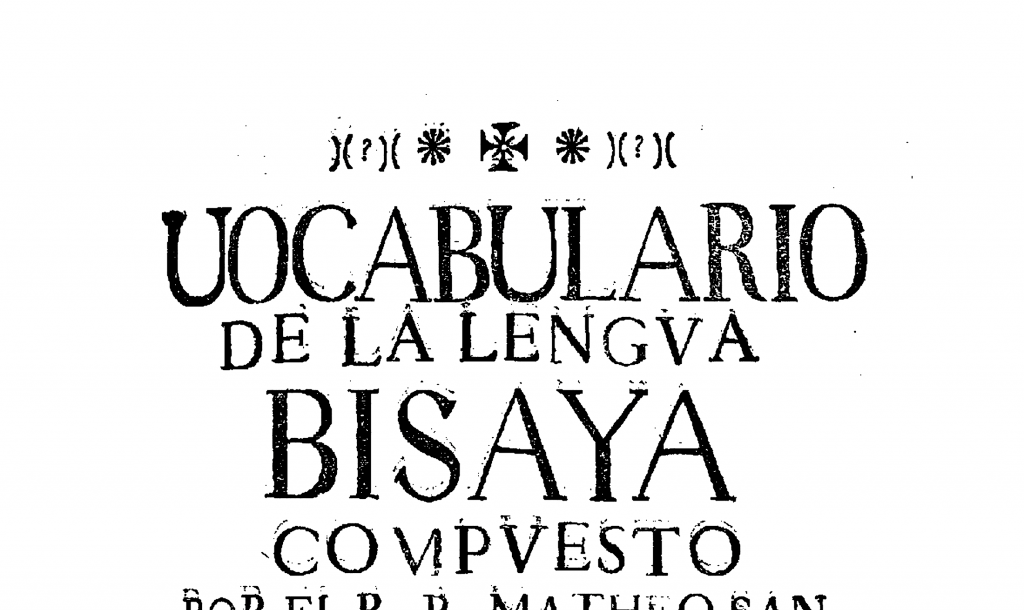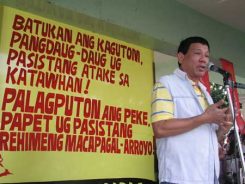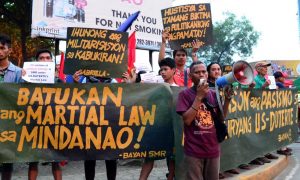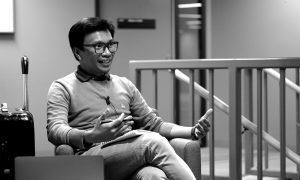Editor’s note: this is the final in a series of posts we’re bringing you this week that feature the views of young writers from President Rodrigo Duterte’s home region of Mindanao on two years of Dutertismo. Previously, lawyer Abdel Jamal Disangcopan reflected on what it means to witness Duterte’s presidency from the perspective of a Mindanaoan who previously admired aspects of Duterte’s local leadership, Jade Mark Capiñanes wrote about “How not to make fun of Rodrigo Duterte”, and Klodye Caday spoke up for the Mindanaoans still resisting Duterte.
I used to have a Tagalog dad. I relish the times when dad dropped me off at school and spoke to me with his Tagalog tongue.
“Tingin sa paligid, ha? Mag-ingat ka pag nasa labas. Pakinggan mo ang mga nasa paligid mo.” “Look at your surroundings, okay? Always be careful when you are in public. Listen to your surroundings.”
This was his constant reminder. My father knew what it meant for his daughter to attend a public school in one of the most dangerous areas of Northern Mindanao.
I liked it when my classmates hear him speak. I can see how mesmerised they were upon hearing a ‘‘foreigner.” I felt privileged. It was something to brag about when I was living in a small barrio, where majority of my Bisaya friends thinks that having a Tagalog tongue is cool. Tagalog is the language we hear on soap operas and primetime news. It makes the lyrics of pop songs and romance novels.
Now, I have a Bisaya dad. After several years of staying in the Mindanao soil with a Bisaya wife and child, my once Tagalog speaking dad now grew to learn Bisaya and made it like his own. With the passing of time, Bisaya and English became the languages of our home.
Before he embraced the Bisaya language, his being Tagalog-speaking almost cost our family’s life. One day, the tambays (bystanders) in our purok (village) ganged up against their new Tagalog neighbour. It happened so fast on a rainy night of the twelfth of June 2006, when I was only ten. They mobbed my dad right before my eyes.
Growing up, I never understood the gravity of language in the mundane, yet the unspoken realities were so pronounced. So pronounced that when Bisayas get a spot on national television or in politics, people would rally for them.
There was Kim Chiu and Gerald Anderson who became an iconic love team for the Pinoy Big Brother Reality show. Then there was Mindanaoan Shamcey Supsup who represented the Philippines in the 2011 Miss Universe Pageant. Way back in 2001, when President Gloria Macapagal Arroyo ran for office, people from Mindanao supported her and claimed her as one of our own, for she spent her summers as a child in Iligan City, where her grandmother lived.
So when the Bisaya Mayor Rody Duterte ran for president, it was a no brainer that Bisaya speakers all over the archipelago rallied behind him.
(2)
I knew the Philippine map like the back of my hand. Our history professor in my freshman year in college, made us draw the archipelago by memory every week for the whole quarter.
Before my history classes in college, I heard about a popular 1990s anecdote about the Question and Answer Portion in a Miss Universe pageant held in Manila. Miss Philippines was asked about the total number of islands in the Philippine archipelago, to which she wittingly responded: “high tide or low tide?”
The crowd applauded the beauty queen.
“Seven thousand one hundred seven when high tide, and during low tide we have seven thousand one hundred eight.” I found that anecdote both witty and educational. This official count was, years later, updated to 7,641 islands.
Today, that island count seems to matter less. In Mr Duterte’s Philippines, the archipelago is no longer composed of 7,671 islands, but divided into two imaginary islands: the Imperial Manila and the Imperial Mindanao. Or more fittingly: the Imperial Tagalog and the Imperial Bisaya.
Mr Duterte revealed that the Philippine archipelago is not geographical at all. That islands aren’t separated by waters, but by biased and privileged notions of language and dialects. The divisions are clearer now, revealing how the Imperial Manila cannot keep up with power of Duterte’s tongue.
(3)
The first time I heard Duterte speak was during my college graduation in 2015. He was our commencement speaker. Our college gym was packed with not only with the graduates’ parents and relatives but also with gate crashers who travelled to the Mindanao State University to hear him speak.
He arrived three hours late. When he finally took the stage, all I could hear was that he kept saying Viagra. As usual, he discarded his prepared speech and went on a meandering speech.
At one point his speech, he started talking about the Mindanao narrative and urged us graduates to fight for Mindanao. He then talked about Viagra again, somehow as his way of saying he needs more energy to attend to the Presidency.
In his first year as president, his public speeches were filled with gutter expressions that a Bisaya child would usually hear in a school fist-fight. His accent is familiar because it is portrayed in Philippine teleseryes and radios, represented by characters like maids, security guards, and promdis (a contraction of “from the province”).
Stereotyped through accents, this has been the content of the national television for a long time and the staple of Philippine humour.
His statements like “Mga pisot pa gyud! (They’re also uncircumcised)!” or when he threatened UN by saying “Kumoton ko na imong nawong!” (“I will crumple your face”) or cuss words in speeches like “yawa,” ‘’lu-lo,” “piste,” or “puta” are just some of his go-to expressions from the gutter.
Does this offend the Filipino people? Some do, but not all. The real question in all of these is: how do we make sense of a man who says these things?
Duterte’s Bisaya identity was crucial in fortifying both his international and local audience. Duterte gets away with his language because he is Bisaya and that he speaks and thinks in Bisaya. And so, a shift has happened, and now, it seems that Bisaya represents the Filipino masses in just a few months after his election. Bisaya becomes the language of the majority.
That he is just “joking” is how his supporters defend what is seemingly indefensible. Mr Duterte is not offensive if only one understands Bisaya. People who do not speak Bisaya do not have the right to be offended for they have no knowledge of the context and what Mr Duterte is really trying to say.
(4)
I went to a forum about President Duterte. A friend of mine argued that his gutter language isn’t representative of the Bisaya people. I challenged my friend and accused him of coming from a privileged upbringing.
I grew up in an barrio in a small city in Mindanao where trading of crystal meth is a daily occurrence. Gang wars are daily news. Gutter language is no longer offensive when I hear it. I hear neighbours yelling the exact gutter language that Duterte speaks.
I didn’t grow up poor, but I happened to live in a very poor village. We do not speak like our neighbours, but we grew to understand them and their context.
“Estoryang Latin” [From Iligan’s term for vulgar-packed conversations—derived from the expression “Bilat ni Nanay”/”Mother’s Vagina”] as the old people would call it which describes how ancient Bisaya would speak.
I’d like to make sense of Duterte as this: He chooses to speak the gutter Bisaya because he is targeting the Bisaya which now represents the masses. His gutter language is offensive, but it is effective. Effective in arresting people’s attention to keep the attention on him and his agenda. It also acts as a distraction and at the same time as polarising factor, which is also part of his agenda.
One of the reasons why he is loved by the Bisaya is that his accent represents the people who, through the language they speak and the accent they possess, are being mocked by non-speakers. Duterte speaking in Binisaya even in national TV is making a statement for the Bisaya people.
Non-Bisaya speakers would always be on a guessing game when it comes to Duterte’s statements. Many Bisaya will let him be. Mr Duterte’s dark humour challenges his listeners to recheck their convictions. We can perhaps speculate that Duterte intentionally makes this as his special language exclusive for the Bisaya people, making them a privileged group.
Tagalogs are left dazed and confused, asking their Bisaya friends and companions for interpretation and translation whenever the President inserts bits and bits of Bisaya expressions and statements. His Bisaya humour divides and creates exclusivity among the Filipino people. The Bisaya gets an upper hand.
The Bisaya people, tired of being misrepresented and stereotyped by their fellow Filipinos, now has a Duterte who’s building up the confidence of the Bisaya people by using his mother tongue. This act reshapes the conversations, especially in the context of Philippine politics.
(5)
But what about the other auxiliary languages in the Philippines? What happens to them?
I’d like to believe that Bisaya became the representative language of the more marginalised languages in the nation. But is this really the case? Could it be that the Bisaya Nation is simply acting like the once-dominant Imperialist Manila? Is Bisaya, as historian Vicente Rafael once pointed out, merely reinforcing the hierarchy of languages that has been evident in the Philippines for a long time?
Duterte’s selective human rights record
The first in our series of perspectives from young writers from Mindanao on two years of Dutertismo.
The country has 7,641 islands. The fragmented Filipino people are separated by seas, rivers, mountains, languages, and biased notions. As a Bisaya, we can choose to assert our dominance over national life, or we can choose to refuse to make the same mistakes of Imperial Manila.
 Facebook
Facebook  Twitter
Twitter  Soundcloud
Soundcloud  Youtube
Youtube  Rss
Rss 



